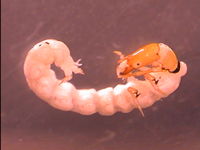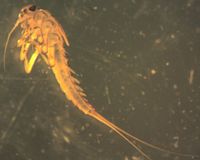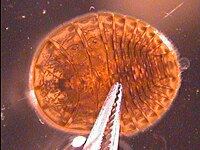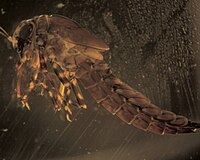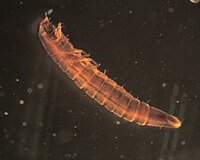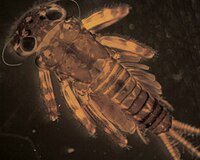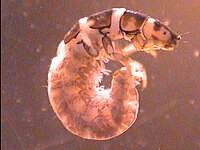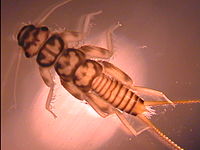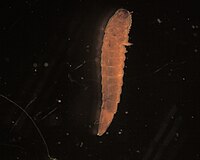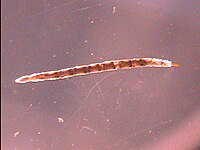Vermont EPSCoR's Streams Project; A Teacher Collaboration on WikiEducator
Openly shared content, practices, and developing resources from Vermont EPSCoR's Streams Project. Join this collaboration and make a difference!
 Stone Bridge Brook |
|---|
|
| Stream code: | LCD_StnBrBrk_133 |
| Basin: | Lake Champlain Direct |
| State or Province: | Vermont |
| Country: | USA |
| Latitude: | 44.677301 |
| Longitude: | -73.205625 |
| School: | Milton High School |
The following are the most common invertebrates collected from this stream site.
Chimarra
- Order
- Trichoptera
- Family
- Philopotamidae
- Genus
- Chimarra
Chimarra are distinguished from the other Philopotamidae by a prominent asymmetrical notch in the frontoclypeus as well as a prominent process on the femur which bears a single hair (seta).
Images of the asymmetrical notch and prominent process.
Hydropsychidae
- Order
- Trichoptera (caddisfly)
- Family
- Hydropsychidae
- Common name
- net spinning caddisfly
- Tied fly
- Emergent Sparkle Pupa, Vermont Hare's Ear
This family of net-spinning caddisflies is very abundant at several sites. They are important filtering collectors and are quite common at urban and agricultural sites where particles of organic material can be important food resources. Genus-level identification is possible for mature specimens and we will include the genera we found at your site if possible.
When using the key, some features that are challenging to see are the forked trochantin and the paired sclerites in the folds between segments. Other, more easily seen key features include filamentous gills on the abdominal segments and the sclerotization of the dorsal surfaces of all three thoracic segments. Keep in mind that with smaller or more immature specimens, genus-level ID may not be possible.
Commonly found genera include Cheumatopsyche, Ceratopsyche, and Hydropsyche. Less commonly, we have found Arctopsyche and Potamyia.
Images of the forked trochantin and the paired sclerites.
Baetidae
- Order
- Ephemeroptera
- Family
- Baetidae
- Common name
- Small minnow mayfly
- Tied fly
- Tiny blue-winged olive
This mayfly has either two or three cerci ("tails") and a unique head shape. Its gills are oval shaped and insert dorsally. Commonly encountered genera include
Acerpenna,
Baetis and
Pseudocloeon.
More information on the genera:
Acerpenna
Baetis
Pseudocloeon
Chironomidae
- Order
- Diptera
- Family
- Chironomidae
- Common name
- Nonbiting midge
- Tied fly
- Griffith's Gnat
Midge larvae tend to be the most common macroinvertebrate at our sites. As with other Diptera, there are no true jointed legs. Chironomidae do have a pair of prolegs at each end and preserved individuals tend to curl into a 'C'. Identification past family requires slide-mounted heads. We have seen philopotamid caddisflies misidentified with the chironomids and we suspect that that happens when samples are being sorted from trays. Under a microscope, six prominent legs can be seen on members of the caddisfly family Philopotamidae.
More information on Philopotamidae.
Psephenus
- Order
- Coleoptera
- Family
- Psephenidae
- Genus
- Psephenus
The true "water penny" is commonly found in the waters sampled.
Psephenus has a rounded shape with relatively smooth edge. The
false water penny, whose edges are serrated, has a more oval appearance. The
gills on the ventral surface are found only in the true water pennies.
Another genus encountered in this family is Ectopria.
Isonychia
- Order
- Ephemeroptera
- Family
- Isonychiidae
- Genus
- Isonychia
- Common name
- The Dun Variant
- Tied fly
- Flick's Dun Variant
This mayfly has unique long hairs on its forelegs as the main distinguishing characteristic (allowing anyone keying to move through quickly). Carefully observe the limbs because such hair can be matted down and therefore hidden in preserved wet specimens. The body of
Isonychia is slim and "minnow-like" when observed dorsally. In specimens we collected, they were commonly brown and substantial in length and width as compared to the very common Baetidae.
Even when individuals are immature, closer inspection can reveal the setae on the forelegs.
Image of the long hair on its forelegs.
Baetis
- Order
- Ephemeroptera
- Family
- Baetidae
- Genus
- Baetis
- Common name
- The Little Olive
- Tied fly
- Sawyer Pheasant Tail Nymph
This mayfly has three "tails" and a unique head shape. Its gills are oval shaped and insert dorsally. More mature nymphs have long, dark wing pads.
Image of the long, dark wing pads.
Stenelmis
- Order
- Coleoptera
- Family
- Elmidae
- Genus
- Stenelmis
The larvae of
Stenelmis, as in
Ordobrevia, have a sternum on the ventral side of the pronotum. The main difference between the two genera is in the antennae the second segment is less than twice as long as the first in
Stenelmis.
The adult Stenelmis has a clear separation between the thorax and abdomen as well as a more distinctly separate head as compared to other genera.
Click here to see pictures of the sternum and
antennae-
Maccaffertium
- Order
- Ephemeroptera
- Family
- Heptageniidae
- Genus
- Maccaffertium
- Common name
- The March Brown
- Tied fly
- March Brown
This genus of
Heptageniidae is distinguished by its gills on the seventh abdominal segment, which are reduced to slender filaments. Gills on segments 1-6 are truncated.
Images of the slender filaments, and the truncated gills.
Ceratopsyche
- Order
- Trichoptera
- Family
- Hydropsychidae
- Genus
- Ceratopsyche
Ceratopsyche has a
forked foretrochantin. The foretrochantin is the projection at the uppermost portion of the foreleg. The leg may need to be pulled away from the body to expose this feature.
Ceratopsyche have a
large pair of sclerites underneath the prosternum. Note: the large single sclerite is the prosternal plate. Biologists have gone back and forth between lumping this genus into
Hydropsyche and splitting it back out. ITIS currently lists it as a genus (Feb 2013) but we are aware of a recent paper that lumped it under
Hydropsyche.
Agnetina
- Order
- Plecoptera
- Family
- Perlidae
- Genus
- Agnetina
Agnetina nymphs have cylindrical, striped abdomens. Like other Plecoptera, they have 2 tails and 2 claws on each tarsus. This genus has three black dots (ocelli) on the top of the head. Click to see the
three ocelli on the dorsum of the head (3 black dots at joint with the pronotum). This stonefly is characterized by the
filamentous gills located in the "armpits". Another important feature is the paraglossae and glossae extending different lengths. The
occiput has a transverse row of evenly spaced little hairs.
Agnetina has another row of evenly spaced hairs on the posterior edge of
abdominal segment 7.
Hydropsyche
- Order
- Trichoptera
- Family
- Hydropsychidae
- Genus
- Hydropsyche
- Common name
- spotted caddis
- Tied fly
- dark cahill
Hydropsyche are net-spinning caddisflies and share most characteristics with other members of the Hydropsychidae, including the
Ceratopsyche.
Hydropsyche are distinguished from
Ceratopsyche by the presence of scale hairs and minute spines on the three most posterior abdominal segments.
More information on the Ceratopsyche can be found here.
Image of the sclerites in the intersegmental folds.
Optioservus
- Order
- Coleoptera
- Family
- Elmidae
- Genus
- Optioservus
The larvae of
Optioservus have open coxae, as determined by the straight definition between segments on the ventral side of the pronotum.
The adult Optioservus have a compact appearance, especially the head and thorax. There are also dorsal ridges and a characteristic diamond-shaped sutellum observable in the dorsal view.
Images of the straight definition between segments, the dorsal ridgesand the diamond-shaped scutellum.
Ceratopogonidae
- Order
- Diptera
- Family
- Ceratopogonidae
- Common name
- biting midges
Members of this family look like very straight Chironomidae. They are very long and thin with a distinct head capsule and no prolegs. Some in the lab call them 'bamboo sticks' with eyes.
Image of the distinct head capsule.
Nigronia
- Order
- Megaloptera
- Family
- Corydalidae
- Genus
- Nigronia
Members of the genus
Nigronia share some superficial commonalities with Trichoptera, but on careful inspection one can see the two pair of anal claws that help place it in the order Megaloptera. The size of mature larvae is impressive; specimens from other genera exceed 8 cm in length. The abdominal segments have ribbon-like gills on the lateral portions. The mouth has mandibles that are serrated and used for biting prey. They can be confused with the more slender whirling beetle larvae; whirligig larvae also have simpler jaws.
Images of the two pairs of anal claws, whirligig beetle larvae and their simpler jaws.

